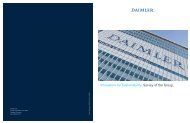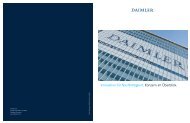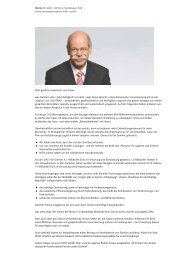Dear readers, This report describes what Daimler means by ...
Dear readers, This report describes what Daimler means by ...
Dear readers, This report describes what Daimler means by ...
Create successful ePaper yourself
Turn your PDF publications into a flip-book with our unique Google optimized e-Paper software.
<strong>Daimler</strong> 360 GRAD - FAKTEN zur Nachhaltigkeit 2008<br />
<strong>Daimler</strong> Nachhaltigkeitsbericht 2008 / Environmental protection, innovation, and safety / Innovation, development and safety / Safety<br />
When accidents happen: Occupant protection on multiple levels. In the development of safety systems,<br />
Mercedes-Benz is guided <strong>by</strong> data generated during 38 years of accident research; our objective is “real-life<br />
safety” – in other words, vehicle safety that is relevant to the everyday hazardous situations encountered in road<br />
traffic. Mercedes-Benz also carries out a large number of different crash tests that go far beyond meeting the<br />
requirements of legislation and ratings, in order to conduct differentiated analyses of various types of collision.<br />
Mercedes-Benz models have attained an exemplary degree of safety over the years, thanks to the development<br />
and introduction of the airbag, automated seatbelts, seatbelt tensioners, seatbelt force limiters, and many other<br />
innovations. Today, the new C-Class station wagon comes with seven airbags as standard equipment. The crashactive<br />
NECK-PRO head restraint is yet another special safety feature offered in the new C-Class and in many<br />
other Mercedes-Benz model series. Like other brand innovations, NECK-PRO’s development was also based on<br />
analysis of actual accidents. The system is equipped with sensors that register rear-end collisions of a predefined<br />
impact force, which is followed <strong>by</strong> the release of pre-tensioned springs in the headrests, causing the upholstery<br />
inside to shift forward and upward in just a few milliseconds, thus supporting the heads of the driver and front<br />
passenger in time to prevent injury.<br />
After an accident: Ensuring faster response <strong>by</strong> rescue personnel; preventing wake-effect collisions. <strong>This</strong> safety<br />
phase involves preventing even more damage or injury following an accident, and getting help to accident victims<br />
as quickly as possible. The sedan and station wagon versions of the new C-Class, for example, are equipped with<br />
a system that automatically cuts off the flow of fuel to the engine in the event of a serious accident. The same<br />
system also automatically engages the hazard lights to warn approaching vehicles and prevent further accidents.<br />
If the front airbags have inflated, the front windows will automatically open slightly in order to air out the interior.<br />
At the same time, the door locks will be released so that injured passengers can be rescued more quickly.<br />
Many systems introduced to the market <strong>by</strong> Mercedes- Benz have subsequently been adopted <strong>by</strong> other<br />
automakers. The resulting widespread use of these systems has helped to prevent many accidents, or to mitigate<br />
the effects of those that do occur, which has reduced costs to the overall economy as well. The innovative safety<br />
solutions from <strong>Daimler</strong> thus not only offer immediate advantages to the Group’s own customers; they also<br />
benefit society as a whole over the long term.<br />
At the beginning of 2007, Mercedes-Benz received the “Car of the Year Award” from the British magazine “What<br />
Car” for the brand’s pioneering safety achievements. That same year, Rodolfo Schöneburg, head of Passive<br />
Safety Development at Mercedes-Benz, was honored <strong>by</strong> the National Highway Traffic Safety Administration<br />
(NHTSA) in the U.S. for the outstanding contribution he has made to vehicle safety. These awards make it clear<br />
to us that we are on the right track as we move closer to attaining accident-free driving.<br />
Assistance systems for active safety














